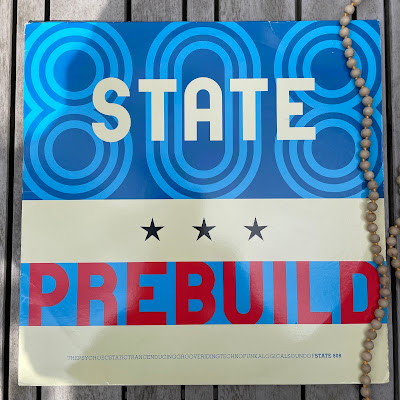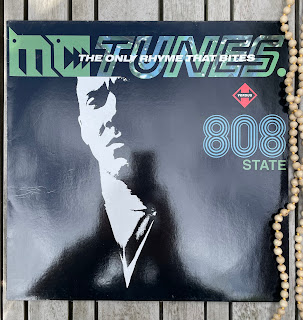For me, “Prebuild” is not an album that you would play to your new girlfriend on the first date, nor on the second, I think. Unless you met at a rave.
Released 15 years after “Newbuild” on Rephlex as a double vinyl, it is the prequel to Newbuild. Even rougher, even more unpolished. In terms of sound, it would actually be a tape only release.
Not a must have release, but also contains some pretty crazy, good acid tracks.
For me, “Massagerama” is the track you could put on on your third date without being asked to stop the music. Then you could switch to “Quadrastate”, which sounds completely different, more melodic and already contains a lot of “Ninety” and THE hit “Pacific”.
I've always been someone for whom the design of a record is just as important as the sound itself. If there were consistent concepts for all products, color design, layout and font types, I was often lost & could definitely buy records, just after look.
808 State had such a concept in their early phase, which they then unfortunately abandoned.
The “Ninety” album inexplicably doesn’t have that wonderful double 808, even though it’s from that era. With “Ex:el” this 808 was reduced to a fingertip width, only to disappear completely with “Gorgeous“. By this album at the latest, my love was only affection. But the music of the first years will always remain, even if it has a Gerald Simpson flavor (see penultimate post).
„It takes Rephlex to dig up one of the classic albums of the year. 808 States Prebuild is compiled from tapes taken from before their seminal first release Newbuild.
The first track Automatic sounds just like A Guy Called Gerald stuff from the same era. Ride isn't bad and neither is Johnnycab although Ride is the weaker track of the two.
The two Lounge Jays tracks sound more like US house tracks especially Sex Mechanic with that overdriven sample and seedy 303 bassline.
Clonezone and Cosacosa are two great acid tracks and its a shame that they end suddenly after just five minutes or so.
The real highlights of course are at the end of the album. K.Narcosa which later surfaced on Newbuild and C.I.S which is just insane. The last track Thermo Kings is taken from a rave held at a Swimming Baths in Manchester and is one of my favourite acid tracks. Sounding like Phutures Acid tracks mixed with Xrays Lets Lets Dance, its 14 minutes of acid that rival anything the U.S produced at that time.
- Fronhornet -
„As a group which mainly specialized in a hybrid of house and techno music, 808 State was, at least in its first half-decade, highly enigmatic. After the band's first release, the tracky, deep acid house collection Newbuild, 808 State avoided the clichés of each genre, and consequently never produced anything that fit comfortably into those styles, or into any others, for that matter. When the products of this labor were coherent, evocative songs that morphed, unfolded, and refolded upon themselves like self-aware works of sonic origami, any unfamiliar aesthetics in them were easy to regard as sheer creativity, examples of a higher order of synthesized dance music. Sometimes though, the results were churning, bombastic messes of percussion and melody working in competition rather than harmony, leading the listener to wonder if a techno band ever need consist of more than two or three people.
The ability of the group to straddle this artistic boundary, erring just on the side of creativity, is perhaps never more apparent than in Quadrastate, a 5½-track mini-album released in 1989. It was a stark departure from Newbuild, instead opening with loon calls, melodic synthesized pads, and of all things, a saxophone solo. Ordinarily, none of those things would bode well, but with the addition of a battery of clever drum programs, a manic bassline, and a suspenseful breakdown, the lead track, "Pacific State", was an instant classic played by every forward-thinking house DJ, and then some. Licensed by ZTT, mildly remixed and released as just "Pacific", the song was a UK Top 10 pop hit.
The rest of Quadrastate was further left-of-center, a set of densely arranged, not-so-radio-friendly material more for the DJs and collectors, but no less adventurous or melodic than "Pacific". The hopping, skipping "Disco State" is almost fully techno, but is built on disco-style octave basslines and seems to be a favorite of my friends despite being the weakest song on the release for me. The strongest track for me is "Fire Cracker", a tune which dramatically emulates its title with every instrument while somehow remaining both listenable and danceable, an astonishing feat still unrivaled two decades later. The repetitive "State Ritual" alternates an ultra-hypnotic casade of staccato flute samples and multiple rolling, roiling basslines against incessantly hammering drum programs, easily earning the title of the busiest, noisiest proto-trance track of its day. "State To State" is an uplifting, anthemic epilogue reminiscent of "State Ritual". By the end, one wants to hear it all over again.“
- MJB -
„After interviewing both names involved in 'Pacific State's production, Gerald Simpson & Graham Massey, here's a unique vision you will have from the days this timeless Classic, back from the end Eighties.
According to Gerald Simpson's testimonials, when ‘Pacific State’ was conceived, there was no plan of doing any specific EP. It was meant to be a Peel Session. “I had already done ‘Emotions Electric’ for it, so I actually thought we would do one as 808 State, but it didn’t happen”.
The original name of ‘Pacific State’ should be ‘Day Ride’. Gerald Simpson reveals how the programming was done: “It started with the strings - Roland D-50 and Roland S-10 to sample it, and the atmosphere came with Derrick May’s ‘Feel Surreal’ on my mind. The Bassline was SH-101 again, triggering the grimpshot from TR-909 to keep the time for the bass, and the 909 to the beats. The Balearic bird sound came from Graham Massey’s Korg machine, and the saxophone was Graham’s performance was only later, after the 1st demo.” The futuristic Space-Techno mentality from the Motor City represented, as he had said before, his biggest inspiration. “For me, the Music of Detroit was something I felt I should be a part of it, even more than Chicago House. Their Music was the perfect soundtrack for the squat I was living in at that time, very industrial, just like theirs. I never wanted to sound like English. The only stuff I was into was Baby Ford back in 88.”
After all, there was a spreading of lot of stuff around like a production-chain factory, over copied music formulas, which Gerald never agreed about. “I just follow my heart, just go after what I feel, I do not work based on the copy of the outside.” The same feeling was pursued from there on, as a main guide for his artistic life. “On the early nineties it seemed that there was no room to experiment furthermore, except for Breakbeats and Jungle”.
Graham Massey also remembered those magic days: ‘Pacific’ was very important in Manchester, at the Haçienda as well. They used to play as the last tune of the night! Such an important thing to us, much more important than being ‘Top Of The Pops’, Pacific was considered was considered a different perspective, just like “Chill Out” by the KLF. It was an ecstasy kind of anthem, at the same time futuristic, and human. The quality of it emotive atmospheres lead you to imaginary places. Roland 909 did the beats and the Roland 727 for the bongo percussive sounds. The basslines and synths were Roland SH-101, and the chords were sampled from the Roland D-50 (which was new synth from 1989) into a sampler to play as a sample, rather than keyboard. The first version there was just the chords and pianos, a lot of which used on tape edits. It wasn’t made in one day, but in three or four sessions of recording. The saxophone was a soprano which I played, like I used to on Biting Tongues. One night before, a friend of mine played a sax and left it and so I decided to experiment with it. It
would help with the identity because the people could go to the shop ask “do you have the record with the birds and the saxophone?”, it made somehow an identity of it. It sounded like some Detroit with the flavor because of the chords, but we were also trying to make something like Marshall Jefferson’s “Open Your Eyes”, we tried to make that warm mood, that atmosphere."
- Alan Patrick -










No comments:
Post a Comment